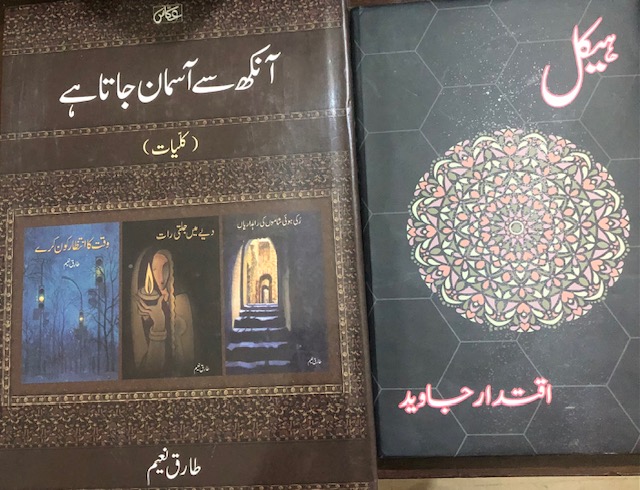Two valued collections of modern Urdu verse
By Syed Afsar Sajid
- ‘Ankh say aasmanjatahai’ by Tariq Naeem (480 pp)
- ‘Haikel’ by IqtidarJaved (176 pp)
Tariq Naeem and IqtidarJaved are now veterans of Urdu poetry with seven and nine miscellaneous literary publications to their respective credit. Lately the former has published his ‘Kulliyat’ viz. ‘Ankh say aasmanjatahai’ (a super-collection of his three poetic anthologies titled ‘Waqtkaintizarkaunkaray’, ‘Diye may jaltiraat’, and ‘RukihuishamoNkirahdariyaN’) whereas the latter has recently brought out his latest verse collection viz. ‘Haikel’ comprising some 82 numbers of ghazal.
‘Ankh sayaasmanjatahai’
Tariq Naeem is a seasoned poet. Nostalgia, stream of consciousness, self-discovery through creativity, river, sand and mirage, night, probability, desert, evening, lamp, and dream are the recurring images in his poetic verbiage. In his prefatory remarks added at the head of the three collections of this ‘Kulliyat’, the poet has ventured to expatiate on the binaries of his poetics such assense and sensation, vision and vanity, reflection and reverie,fantasy and fear, dogma and doubt,angst and agony, delight and despair. In the modernistic sense, his poems epitomize introversion, inquisition, and inflexion.
The diction of Tariq Naeem’s verse is syntactically sound,and unblemished too. It has an aura of simplicity about it. The tone and tenor of his style in verse is characteristically unaffected by any conceit or equivocation. The metaphoric grace of his lines is enhanced by an innate melodic felicity peculiar to their aesthetic design. Noted litterateurs and poets Syed MujtabaHaiderShirazi and Anjumkhaliqhave contributed eloquent forewords to the book in view. They have delved deep into the mechanics as well as merits of Tariq Naeem’s verse in general and the three works constituting the collection ‘Ankh say aasmanjatahai’, in particular. The dictum that literature (and in essence poetry) expresses, represents and communicates experience by means of language can pertinently be applied to this brand of poetry which is the expression of language for its own sake, of experience for its own sake. In it the experience of receiving the communication, and the experience communicated are indistinguishable.
Here are some lines from the book intended to acquaint the reader with the style and complexion of Tariq Naeem’s poetics:
AbgirahuN to hoshayahai/MaeiNhawa par sawar that pahlay
Ajeebbaatbataihaiaainay nay mujhey/Haraik ankh may pinhaNjamal-e-aainahai
Ek din jonaguzra to kisayyaadrahuNga/HarrozeguzartahuNsar-e-sham jahaN say
HazaroNkhwabdaikhay par bhiyehkhultanahihai/Mritabeerkokiskhwab may rakhagayatha
BadalrahayhaiNbahutzindagikaypaimany/Naeysiray say maeiNiskanisablikhuNga
Yehkischaraghkolayagayahaimaqtal may/Mahekuthahaiandherabhiraushnikitarah
Maeinundar say kahiNtootahuahuN/Mujheybahar say jorajarahahai
Is tarah zarf-e-hawaaurbhikhulsaktahai/Ekdiyaaursar-e-baamjalayajaaey
Tamashabarhrahahaiaakhrilamhatkijanib/Tamashagarbhikhudekiste’arahonaywalahai
‘Haikel’
This is famed poet and column writer IqtidarJaved’s latest verse collection, in fact his third collection of ghazal. Commendatory opinions of FarrukhYar, ArifaShahzad, and Ata-ul-HaqQasmi are mentioned on the flaps of the book which, as already indicated, comprises 82 numbers of his ghazal.
Ata-ul-HaqQasmi praises the form, content, and style of IqtidarJaved’sghazal that mark an instant impression nay impact on the reader. His poetry seems to be an artistic fusion, as it were, of his knowledge, wisdom, experience and sense perceptions, his unconventional modernistic phraseology notwithstanding. Like the metaphysical poets, he too tends to synthesizethe intricate processes of his thought and feeling into a palpable whole, directed to enlighten the reader on the subtleties of his poetic art besides underlining the conflict between the development of the moral sense and the dehumanized world picture provided by the discoveries of the scientists.
Here are a few quotes from the book meant to illustrate the preceding observations:
Aeyshayr-e-kargar tri taufiqshukriya/Maienthadua to harf-e-duakardiyamujhey
Alfaazaurqawafi, tarakeebaurishq/Hum logoNwastaykoi gulzarkhulgaya
WahaNhumlogpahunchay to savera ho rahatha/Ba harsuChe Guevara Che Guevara ho rahatha
Neechaydo’abay may zaraaanaykidayrthi/Seenafarakh ho gayadarya-e-tang ka
Aik Big Bang thaphooloNkichatak say nikla/Kaamsui say nanikla to palak say nikla
HamarineeNdhai so toot-tihaidarmiyaN say/Hamaramulkhai so ibtilajariraheygi
EkhaqiqatjobayaNkartahuNmaeiNalfaaz may/ChahtahuNjistarahaisaybayaNhotinahiN
FarrukhYar, a contemporary poet, critic, and intellectual, has rightly averred that the ghazal of ‘Haikel’ is like a vast but luminous realm of experimentation which is ever-expanding to the benefit of its umpteen practitioners.























